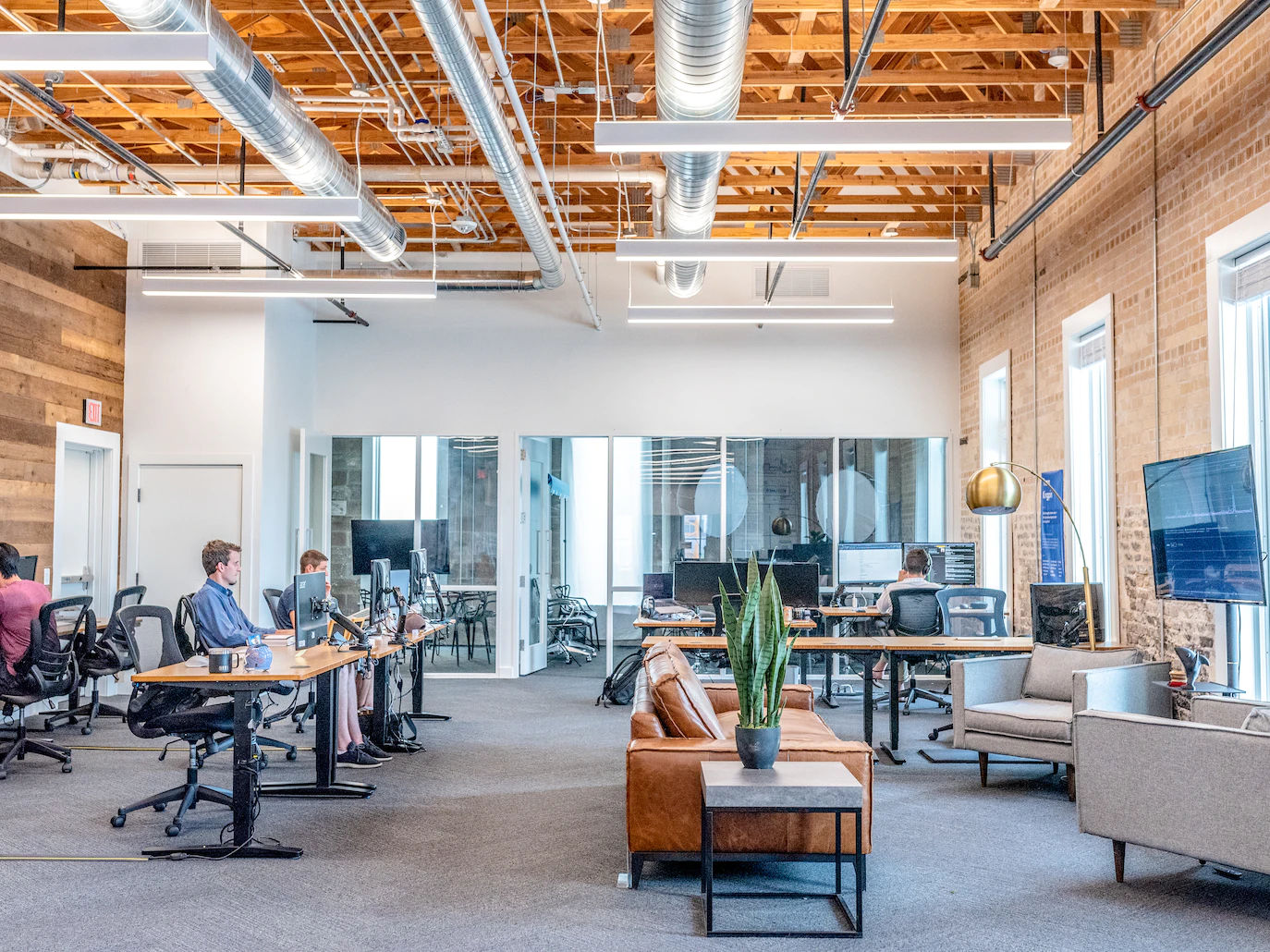Monday 21st August 2023
How you can maximise your team’s (and your own) productivity and happiness
Laura Beales
9 minute read

Having spoken with over 1,000 business leaders and employees, this report provides information about productivity-related issues in hybrid workplace and provides actionable ways to tackle them.
The Issues

This report focuses on two main issues companies face in maximising their employees’ productivity in the workplace:
Maximising employees’ happiness
Leading academic research has demonstrated that employee happiness is one of the chief determinants of productivity in the workplace.
Ensuring employees work in a way that allows for maximum focus
It is imperative that employees undertake productive ‘focussed’ and “collaborative” rather than unproductive ‘busy’ work.
Productivity and Happiness
Employee productivity and happiness are best understood as self-reinforcing elements of a ‘virtuous circle’ whereby each creates and maximises the other.
Productivity leads to happiness...
Recent academic studies have confirmed the link between happiness and productivity. A 2019 Oxford University study found that happy employees were 13% more productive, while research by the University of Warwick in 2021 supported these findings, putting the figure at 12%.
...and happiness leads to productivity!
For decades, psychologists such as Maslow have indicated the deep-seated need amongst humans for ‘self-actualisation’ - the feeling that one is fully exploiting their talents and living up to their potential. It is therefore crucial for employees’ mental health and wellbeing that they are undertaking meaningful and efficient work.
The Two Types of Work
FOCUSSED WORK
Work where you are concentrating on cognitively difficult tasks without distractions
Also referred to as ‘deep work’ or a ‘flow state’, focussed work is all about working on a stimulating yet achievable task with few to no distractions.
"Deep work will make you better at what you do, achieve more in less time and provide the sense of true fulfilment that comes from mastery of a skill" (Deep work, Cal Neuman)
A McKinsey Report on focused work and ‘flow’ states found that top executives were 5 times more productive when in this state and that if one can increase the time spent in this state by 15-20%, their overall productivity doubles.
"If for the entire week you spend 2 hours per day in a flow state, you’ll get as much done as most people do in an average 40-hour workweek." (Work in a flow state, Jari Roomer)
COLLABORATIVE WORK
Work that involves several individuals, teams, and organisations coming together to achieve a common goal.
Although the focussed work model is most effective for complex individual tasks, many jobs require collaboration.
Collaborative work at its best involves workers who know and trust one another coming together to reach a collective solution that is greater than the sum of their parts.
At its worst, it can resemble busy work, dragging employees away from deep work into meetings and discussions where they feel that they cannot contribute or learn.
£45 billion
A consultancy.uk estimate of how much the UK economy lost to pointless meetings in 2019.
How to reduce busy work

What can individuals do?
1. Don’t write a to-do list, create a schedule
Knowing what you need to do is very important.
However, as Newport’s Principle of Least Resistance’ argues, to-do lists can encourage us to complete ‘busy jobs’ first. Most people seek out easy wins and, low-value tasks while avoiding more complex and value-adding ones. Schedules don’t just set out what you want to do, but how much time you want to spend on each task, giving your day structure. They also enable you to schedule periods with no distractions for focused work.
2. Let people know your policies
Even if your company doesn’t have internal policies on response times, set your own. Set your own reasonable response time and stick to it.
3. Turn-off distractions
If you know you only need to respond to emails/Slack a few times per day, turn off notifications the rest of the time. Try to have at least a few hours of work per day notification-free.
4. Experiment and learn from your schedule
Everyone is unique and you need to learn how you work best; experimenting and determining when your energy levels are highest is key to this. If you find something works for you then stick with it!
“When the day starts with a small win, the momentum continues” - David Rusenko, founder of Weebly, who spends nearly every morning on the phone with customers
5. Be honest with yourself
Most people spend too much time on busy work because it is easier to do and gives the illusion of productivity. Actively recognise when you are doing busy work and hold yourself accountable.
What can companies do?
1. Don’t expect employees to be ‘always on’
Your employees don’t need to respond to you - or their colleagues - instantly. Set clear timelines for how quick you expect internal responses.
2. Have rules for communications software
If you use software that is distracting, have rules about how it is used. Aim to have periods every day where people turn off Slack notifications or have a ‘no meeting day’ each week.
3. Lead by example
Although it might be difficult to accept, the very nature of focused work means that employees should not respond to you instantly. Schedule your emails to align with their schedules so they don’t feel they have to be ‘always on’.
How to do focused work
Try out some of these strategies to help prevent distractions getting in the way of high-quality work time.

How to focus?
Set a timer
The Pomodoro Technique is a great way to focus on large, challenging tasks. Set a timer for 25 minutes and tell yourself to only work until it ends then have a 5 minute break. Try increasing the timer by 5-10 minutes each time
Find the right work environment
Science has shown that although some people get distracted by excess noise, for others it creates lateral connections that result in more creativity.
It is therefore best to figure out what work environment works best for you. Think back to when you have completed your best work and what sort of environment it was done in. Experiment by working in co-working spaces with a certain ‘buzz’ as well as quieter spaces with a calmer feel to them. You can check out a variety of such venues on Tally Workspace.
Take Breaks
Leading psychologists now agree that it is impossible to maintain focused concentration for more 90 minutes in a row or 4 hours per day. At a point, pushing yourself to work those few extra hours becomes counterproductive. Instead, take a break to clear your head, go for a walk or grab a coffee with a friend.
How to help your team focus

How can company leadership encourage focused work?
1. Provide clear long-term goals
If you want your team to focus and achieve their goals they need to understand the bigger picture. Make sure you are being clear on the larger goals so that they focus their attention on the correct tasks.
2. Improve employees’ work equipment
Poor work equipment is going to lead to frustrated and unhappy employees who are less productive. Talk to your employees about what could be done to make them more productive and ensure they have access to all the tools they need to do their job properly.
3. Provide flexible workspace and working policies
Commuting three hours a day to go to an office is a waste of time if an employee is planning to do individual focused work. Likewise, forcing employees to work at home is counterproductive if they’d rather be amidst the buzz of a coworking space or need to need their team. Offer your workers the flexibility to work where they work best via Tally Workspace.
4. Recognise and reward great work
As Dr Ashley V Willans of Harvard Business School argues, “what really matters in the workplace is helping employees feel appreciated”, and this doesn’t just mean throwing money at employees through bonuses and out-of-cycle salary increases. In fact, Dr Willans’ work has demonstrated for the majority of people, what really makes employees feel appreciated are more thoughtful and individualised perks that need not cost the company a huge chunk of their budget. This can include a public congratulating of the high-performing worker, individualised perks and bonuses with personal notes, or even a simple “thank you”.
5. Time it right
Science has shown that the morning lark/night owl typology is real: plan accordingly. Allow your employees the flexibility to work later or earlier if they wish. Some people will thrive when they can spend the first hours of their morning planning, attending meetings and responding to emails. Encourage employees to pay more attention to when they work best and allow them to work more flexible hours.
6. Look after yourself
The trick to getting more work done isn’t to work more, it’s to work smarter and include self care in your schedule. Encourage your employees to get enough sleep by allowing them to avoid working late by turning off notifications and provide them the necessary support so they can uphold their physical and mental health by providing exercise facilities and free therapy sessions.
How to undertake collaborative work

Though collaborative work is crucial to all successful businesses, three quarters of UK workers say that at least 30% of their meetings are pointless. So how can you ensure that when your team comes together this time is spent productively?
1. Make meetings as long as they have to be. No longer, no shorter
One of the biggest problems employees say they face today is that meetings last too long. Conversely, many also rue meetings that are too short and attempt to cram too much into a short period of time. In this spirit, if you’ve booked a meeting room for a specific period of time, don’t feel obligated to completely fill that time if it’s not needed.
2. Meetings don’t always have to be formal
Meetings are inherently a creative process. Location and atmosphere matters. Think about what you want to get from a meeting plan it accordingly. You might find it more conducive to success to sit in a less formal atmosphere and have a chat, walking meetings can be productive and sometimes you need space to write all over the walls.
3. Make sure everyone knows each other
“Team building” exists for a reason, and numerous studies have shown that teams who trust each other and know each other as individuals perform better by asking one another better questions and minimizing miscommunication. Take time in and out of meetings to ask people genuine questions - not just “how was your weekend?” but “how was the Fulham game?” Take your team out for drinks or coffee - don’t view this as a cost but an investment in a genuine team spirit and togetherness that will persist when challenges emerge.
4. Train meeting leaders
Leading productive meetings is a skill. Train up those leading meetings to understand how to balance priorities and ensure minimal employee time is lost. At the least, encourage your employees to consult a few helpful articles such as these two from the Harvard Business Review and the New York Times.
How Tally Workspace can help
It’s time to think differently about how we work and where we work best. By embracing flexible & remote working, employers can make employees happier, whilst improving productivity and reducing costs.
Tally Workspace gives every member of your team the ability to work from any of the 1,200 coworking and hospitality venues that suits them best. We exist because 86% of employees want to work somewhere other than the office at least once per week, but 51% of employees do not have good facilities to work at home.
- Offer your team the opportunity to work from over 1,200 workspaces across the UK
- Only pay for workspace used by your team
- Enable your team to collaborate in person as and when required
- Clear visibility of all bookings within the platform and in Slack.
“By having different locations and spaces, one can work alone in a different spot, or with colleagues on a collaborative basis, and certainly mixing it up helps to stimulate creative thoughts. ” - Romaine Thomas, CEO of Juggle Jobs
Useful Resources:
Books:
- Deep Work: Rules for Focused Success in a Distracted World by Cal Newport
- Atomic Habits by James Clear
- Eat That Frog!: Get More of the Important Things Done - Today! by Brian Tracy
Blog articles:
- Work In A Flow State For 2+ Hours Per Day Using The ‘3C Method by Jari Roomer
- How to run incredible team meetings by Meghan Keaney Anderson
Videos:
Written by Laura Beales
